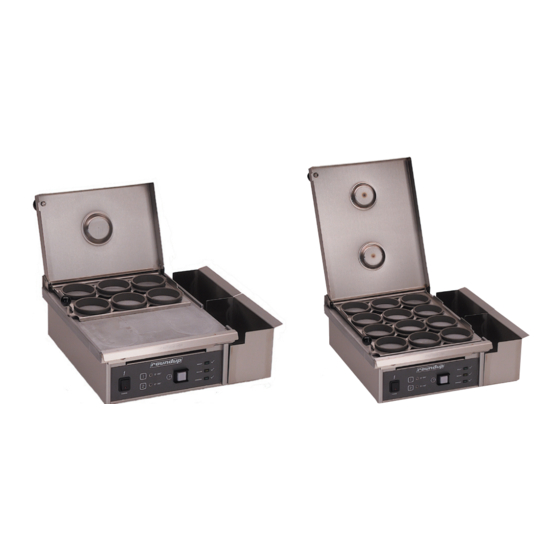A.J.Antunes 9300542 Manuel - Sayfa 9
Yumurta Pişirici A.J.Antunes 9300542 için çevrimiçi göz atın veya pdf Manuel indirin. A.J.Antunes 9300542 14 sayfaları.

Control Board LEDs
The Control Board has three on board LEDs (Figure 6)
to determine the status of the unit and to assist in
troubleshooting.
Green (Diagnostic): This LED should be off in nor-
mal operation. However, if any of the 5 potential faults
are detected by the Control Board, this LED will blink
repeatedly either 1 through 5 times with a 2 second
pause in between. See the Green LED Blink Codes
section below.
Yellow (Audio): When lit, this LED indicates that the
Control Board is supplying approximately 10-15 VDC to
the audio signal. The audio signal should sound when
this LED is lit.
Red (Heat): When lit, this LED indicates that the
Control Board is calling for heat by supplying VDC to
the Solid State relay terminals 3(+) and 4(-). When off,
this means that the grill platen is up to operating tem-
perature and satisfied.
Green LED Blink Codes
Number of
Blinks
The Green LED
Control Board's EEPROM memory is
blinks on and off
corrupted.
1 time, pauses for
2 seconds, and
repeats
The Green LED
The ambient temperature within the con-
blinks on and off
trol compartment has exceeded 155º F
2 times, pauses
(68º C). Verify that the unit has proper
for 2 seconds, and
air ventilation all around it and that it is
repeats.
not near a significant heat source.
The Green LED
Open or disconnected Thermocouple.
blinks on and off
3 times, pauses
for 2 seconds, and
repeats.
The Green LED
Supply voltage to the unit is below 160
blinks on and off
VAC or above 265 VAC.
4 times, pauses
for 2 seconds, and
repeats.
The Green LED
The 50/60 Hz signal has been lost due
blinks on and off
to a loose, disconnected, or an open
5 times, pauses
wire harness/wiring on the AC Isolator
for 2 seconds, and
Board, or from the AC Isolator board to
repeats.
the Control Board.
P/N 1010877 Rev. E 01/05
McDonald's
TROUBLESHOOTING (continued)
Cause(s)
9
MANUAL EGG COOKER/STEAMER
������
���
�����
����
������
���
���
����
Figure 6. Control Board
LEDs
NOTE: During heat mode, this Red LED is very dim,
so it may be difficult to verify if the Control Board
is or is not calling for heat. It is recommended
that you observe the small round green LED on the
Solid State Relay (Figure 7) for mode and diagnos-
tic purposes. When the green LED on the Solid
State Relay is on, it means that the Control Board is
calling for heat. When off, it means that the Control
Board is NOT calling for heat.
Unit's State and Resolution
In this state, the unit turns off the control signal to the Solid
State Relay and disables all front buttons and front lights.
The unit will not heat up. This continues until the defaults are
reloaded into the memory. To reload the defaults, turn the unit
off, press and hold the Time 2 button, turn the unit back on,
and then release the button.
In this state, the unit turns off the control signal to the Solid
State relay and disables all front buttons and front lights. The
unit will not heat up. This continues until the ambient tempera-
ture within the electrical compartment drops below 140 F (60
C) and the unit is turn off and turned on again.
In this state, the unit turns off the control signal to the Solid
State Relay and disables all front buttons and front lights. The
unit will not heat up. This continues until the Thermocouple is
reconnected or replaced and the unit is turned off and turned
on again.
In this state, the unit turns off the control signal to the Solid
State Relay and disables all front buttons and front lights. The
unit will not heat up. This continues until the supply voltage is
within the proper limits and the unit is turned off and turned on
again.
In this state, the unit turns off the control signal to the Solid
State Relay and disables all front buttons and front lights. The
unit will not heat up. This continues until the 50/60 Hz signal is
reapplied and the unit is turned off and turned on again.
Solid State
�� ��� ������ ���
Relay
LED
������
.
�������
������� �������
�
�����
���� ���
Figure 7. Solid State
Relay
